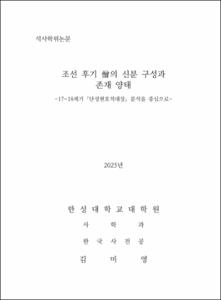조선 후기 僧의 신분 구성과 존재 양태
= The Status and Existence of Buddhist Monks in Late Joseon : A Study Focused on 17th-18th Century Danseong Hojeok
- Type
- Thesis
- Alternative Title
- 17~18세기 『단성현호적대장』 분석을 중심으로
- Department
- 대학원 사학과
- Issued Date
- 2025
- Publisher
- 한성대학교 대학원
- Keyword
- 단성현호적대장(丹城縣戶籍大帳); 승(僧); 위승(爲僧); 승역(僧役); 신분(身分)
- Files in This Item:
-
-
Download
 200000862213.pdf
기타 데이터 / 884.42 kB / Adobe PDF
200000862213.pdf
기타 데이터 / 884.42 kB / Adobe PDF
-
Items in Repository are protected by copyright, with all rights reserved, unless otherwise indicated.